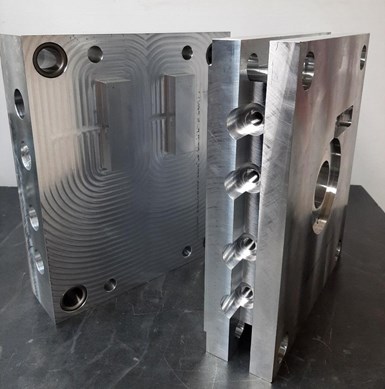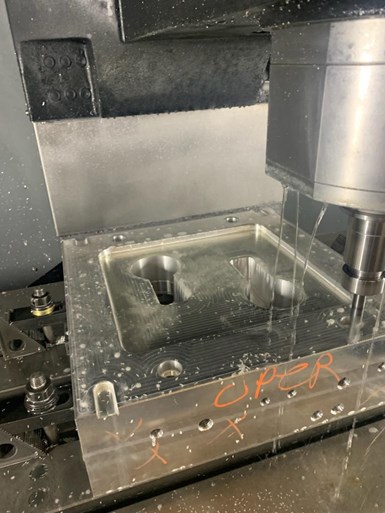
A and B plates of an aluminum mold with straight-through and angled cooling channels. Photos credit, all images: American Quality Molds
Many manufacturers are concerned with reducing their energy consumption — some due to environmental concerns and others because saving energy means saving money, which goes directly to the bottom line. For example, if your profit margin is 10% and you generate 3% savings, that equals a 30% increase in sales volume. In other words, saving $3,000 per year is equivalent to a $30,000 increase in sales volume per year. Of course, if your profit margin is only 5%, it would take a $60,000 increase. This may seem elementary, but in my experience, many companies do not understand this concept.
Here are nine areas of energy savings and increased production efficiency/cost savings that aluminum molds can provide:
Featured Content
1. Weight. Aluminum is one-third the weight of steel. At the beginning of the production cycle, this weight advantage translates into savings with shipping — less weight equals less energy (fuel) for shipping, which means lower transportation costs.
If designed and run correctly, an aluminum mold can run hundreds of thousands and even millions of parts using a single mold.
2. Worker health and safety. Lighter aluminum molds are prone to reduce operator fatigue and injury when handling molds, which becomes even more prevalent with frequent mold changeouts.
3. Machining. With aluminum, sawing the material to a basic size and machining the mold base and cavity requires only one-third of the horsepower per cubic inch of metal removed. Aluminum also machines faster than steel, providing significant energy savings and decreasing time and production costs.
4. Heat treatment. Aluminum molds do not require post-machining heat treatments like steel molds, and although pre-hardened steels may not require further heat treatment, they require more energy (horsepower per cubic inch of metal removed) and time to machine.

Finished aluminum mold on a vertical machining center.
5. Press size. Aluminum’s reduced weight enables a mold to run in a smaller press, which requires less energy to operate, maximizing output per kilowatt-hour.
6. Cycle time. Increased molding speed lowers the required energy to produce each part, yielding more parts per hour and lower part cost (from reduced labor costs per part).
7. Surface finish. Because aluminum is a “soft” material, it tends to even out the microscopic molecular hills and valleys while used over time, providing a better surface finish of a molded part than a steel mold.
8. Cooling channels. Thermal characteristics enable readily machined, straight-through drilled cooling channels, providing production speeds similar to those achieved via metal 3D-printed, conformal-cooled inserts.
9. Recycling. Aluminum is one of the most recyclable metallic materials available. The Aluminum Association notes, “Making recycled aluminum only takes around 5% of the energy needed to make new aluminum — reducing carbon emissions and saving money for businesses and end consumers. As a result, nearly 75% of all aluminum ever produced is still in use today.”
While many of these energy saving opportunities associated with aluminum molds seem obvious, the true potential of aluminum molds is not. The misconception that aluminum molds are useful only for prototyping and short-run production persists. However, if designed and run correctly, an aluminum mold can run hundreds of thousands and even millions of parts using a single mold.
RELATED CONTENT
-
2022 Sourcing & Technology Guide: Mold Materials
Proper selection of the appropriate mold material is critical to manufacturing a high-quality mold. Tool steel, aluminum, copper and alloys are some of the materials used.
-
Technology and Sourcing Guide 2023: Mold Materials
Proper selection of the appropriate mold material is critical to manufacturing a high-quality mold. Tool steel, aluminum, copper and alloys are some of the materials used.
-
What to Look for in Aluminum Mold Alloys
The importance of strength, anodization, weldability, machinability, flatness and porosity to aluminum injection and thermoform molds.















